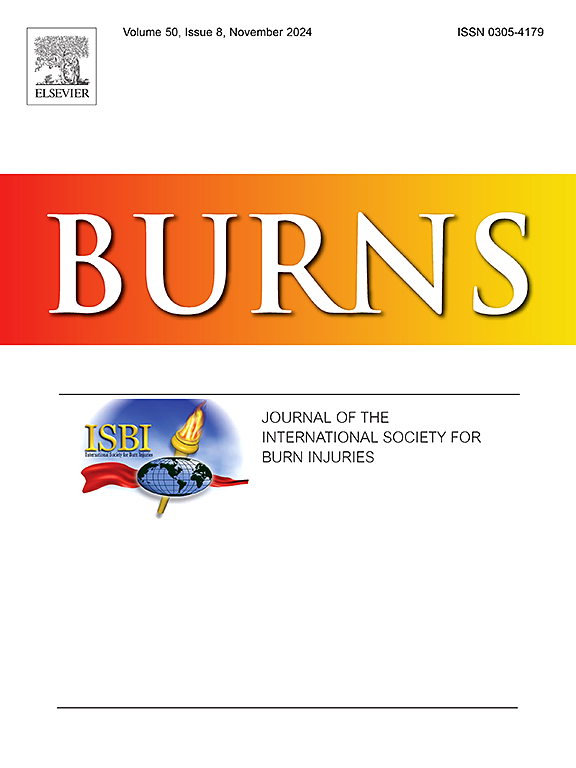A novel model of post-burn hypertrophic scarring in rat tail with a high success rate and simple methodology
IF 2.9
3区 医学
Q2 CRITICAL CARE MEDICINE
引用次数: 0
Abstract
Background
Hypertrophic scars present a serious concern after surgeries and trauma, particularly with the highest risk following burn injury. The current modeling methods usually involve relatively complicated surgical operations and special equipment, and have unstable reproducibility and reliability. This study aimed to establish a simple and reliable model of post-burn hypertrophic scarring in the rat tail.
Methods
Wet gauze saturated with hot water (94–98 °C) was applied to the dorsal side of the rat tail for varying durations to induce burn injury. Wounds were left exposed until completely healed, and the optimal duration for scalding treatment was determined based on gross examination. Thereafter, the optimal scalding duration was used again to evaluate scar formation over time, which was tracked through hematoxylin-eosin (HE) and Masson staining, immunohistochemistry of scar-related proteins and number/distribution of vascular endothelial cells, and picrosirius red staining to measure the quantities and proportion of type I and III collagen.
Results
The scalding duration which led to optimal post-burn scarring was 15 s, with an overall success rate of 87.5 %. Complete healing of the wound occurred after roughly 30 days, leading to the formation of scars grossly red in appearance, tough to the touch and raised compared to the surrounding skin. Microscopically, the epidermis and dermis of the scar were significantly thicker than normal rat tail skin, and the dermis of scar contained a large number of disorganized bundles of fine filamentous collagen. We also observed a significant increase in the number of TGF-β1-positive cells and capillaries in the dermis (p < 0.05). Picrosirius red staining showed that compared to type III collagen, the expression of type I collagen was more dominant in scar tissue, and was more finely distributed than in normal rat tail skin.
Conclusion
We successfully established a model for post-burn hypertrophic scarring, utilizing reliable and simple techniques and materials, which could simulate the biological characteristics of post-burn scarring. Our innovative model has the potential to facilitate the study of post-burn wound healing and scar formation.
烧伤后大鼠尾部增生性瘢痕的新型模型,成功率高,方法简单。
背景:肥厚性疤痕是手术和创伤后的一个严重问题,尤其是烧伤后的疤痕风险最高。目前的建模方法通常涉及相对复杂的手术操作和特殊设备,且重现性和可靠性不稳定。本研究旨在建立一种简单可靠的大鼠尾部烧伤后增生性瘢痕模型:方法:将蘸有热水(94-98 °C)的湿纱布贴在大鼠尾部背侧,以诱导不同持续时间的烧伤。伤口暴露直至完全愈合,根据大体检查确定最佳烫伤时间。此后,再次使用最佳烫伤时间评估疤痕形成的时间,并通过苏木精-伊红(HE)和马森染色、疤痕相关蛋白和血管内皮细胞数量/分布的免疫组化以及测量 I 型和 III 型胶原蛋白数量和比例的 picrosirius 红染色来跟踪疤痕的形成:烫伤后形成疤痕的最佳烫伤时间为 15 秒,总成功率为 87.5%。约 30 天后伤口完全愈合,形成的疤痕外观呈红色,触感坚硬,与周围皮肤相比隆起。显微镜下,疤痕的表皮和真皮明显比正常鼠尾皮肤厚,疤痕的真皮中含有大量杂乱无章的细丝状胶原束。我们还观察到真皮层中 TGF-β1 阳性细胞和毛细血管的数量明显增加(p 结论):我们利用可靠、简单的技术和材料成功建立了烧伤后增生性瘢痕模型,该模型可模拟烧伤后瘢痕的生物学特征。我们的创新模型有望促进烧伤后伤口愈合和疤痕形成的研究。
本文章由计算机程序翻译,如有差异,请以英文原文为准。
求助全文
约1分钟内获得全文
求助全文
来源期刊

Burns
医学-皮肤病学
CiteScore
4.50
自引率
18.50%
发文量
304
审稿时长
72 days
期刊介绍:
Burns aims to foster the exchange of information among all engaged in preventing and treating the effects of burns. The journal focuses on clinical, scientific and social aspects of these injuries and covers the prevention of the injury, the epidemiology of such injuries and all aspects of treatment including development of new techniques and technologies and verification of existing ones. Regular features include clinical and scientific papers, state of the art reviews and descriptions of burn-care in practice.
Topics covered by Burns include: the effects of smoke on man and animals, their tissues and cells; the responses to and treatment of patients and animals with chemical injuries to the skin; the biological and clinical effects of cold injuries; surgical techniques which are, or may be relevant to the treatment of burned patients during the acute or reconstructive phase following injury; well controlled laboratory studies of the effectiveness of anti-microbial agents on infection and new materials on scarring and healing; inflammatory responses to injury, effectiveness of related agents and other compounds used to modify the physiological and cellular responses to the injury; experimental studies of burns and the outcome of burn wound healing; regenerative medicine concerning the skin.
 求助内容:
求助内容: 应助结果提醒方式:
应助结果提醒方式:


